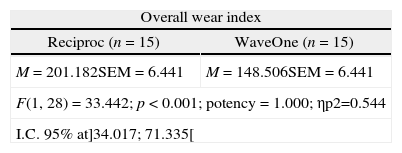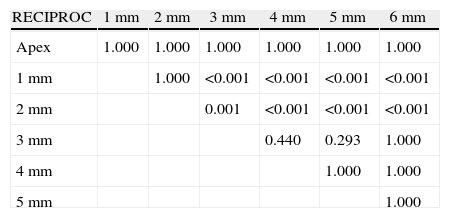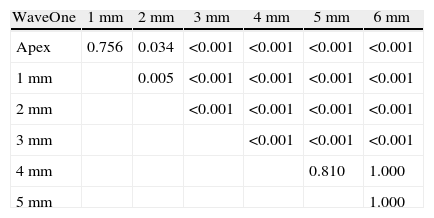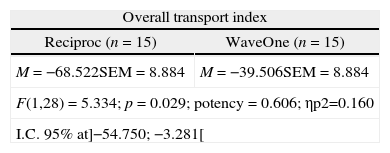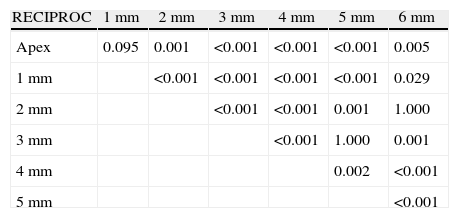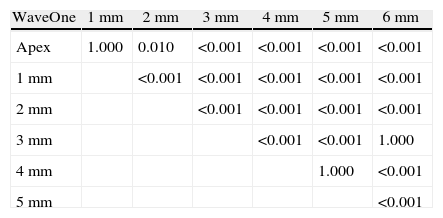To evaluate the degree of wear and transport index associated with the use of RECIPROC®versus WaveOne®.
Materials and methods30 Acrylic cubes with simulated canals were used, all geometrically identical. These were identified and photographed, being randomly assigned to two groups: G1-RECIPROC® using R25 file, and G2-WaveOne® using the Primary file. In both groups the canals were previously catheterized with K10, K15 and K20. The instrumentation was always followed by 2.5% NaOCl irrigation. After the instrumentation, the cubes were photographed again in the stereomicroscope and the resulting images were superimposed using Photoshop CS5 (v12.1, Adobe®), evaluating the differences between the two preparations with ImageJ (v1.45, NIH®) by means of comparative measurements in the apex and at 1, 2, 3, 4, 5 and 6mm.
ResultsAll data was evaluated using ANOVA repeated-measurements test after verification with Kolmogorov–Smirnov test. The degree of wear obtained by RECIPROC® (M=201182) was superior and significantly different (p<0.001) than the preparation obtained by WaveOne® (M=148506). The dimension of the effect was very high (ηp2=0.544) being the confidence interval 95%. The transport index for RECIPROC® (M=−68522) was superior and significantly different (p<0.029) than the transport obtained with WaveOne® (M=−39506), being the dimension of the effect moderate (ηp2=0.160) for an IC of 95%.
ConclusionsWith the limitations of this pre-clinical study, we conclude that WaveOne® accounts for lower canal wear and superiorly centered preparation when compared with RECIPROC®.
Avaliar o grau de desgaste e o índice de transporte usando as limas RECIPROC®versus WaveOne®.
Materiais e métodosForam usados 30 cubos de acrílico com canais simulados e geometria idêntica. Estes foram identificados e fotografados, sendo aleatoriamente distribuídos por dois grupos: G1-RECIPROC® usando a lima R25 e G2-WaveOne®, usando a lima Primary. Nos dois grupos os canais foram previamente permeabilizados com limas K10, K15 e K20. A instrumentação foi sempre acompanhada de irrigação com NaOCl a 2,5%. Após instrumentação, os blocos foram fotografados em estereomicroscópio e as imagens resultantes foram sobrepostas com as iniciais em Photoshop CS5 (v12.1, Adobe©), avaliando-se posteriormente a diferença entre as duas preparações em ImageJ (v1.45s, NIH©) por via de medições comparativas no ápex e a 1,2,3,4,5 e 6mm.
ResultadosOs dados foram avaliados por meio de teste ANOVA de medidas repetidas após verificação com o teste de Kolmogorov-Smirnov. O grau de desgaste obtido pelo sistema RECIPROC® (M=201 182) foi superior e significativamente diferente (p<0,001) do alargamento obtido com WaveOne® (M=148 506). A dimensão do efeito é elevada (η2p= 0,544) sendo o I.C. a 95%. O índice de transporte para o sistema RECIPROC® (M=−68 522) foi superior e significativamente diferente (p<0,029) do transporte obtido para o método WaveOne® (M=−39 506), sendo a dimensão do efeito menor (η2p= 0,160) para um I.C. a 95%.
ConclusõesCom as limitações deste estudo pré-clínico, conclui-se que sistema WaveOne® permite menor grau de desgaste canalar, bem como uma preparação mais cêntrica comparando com o sistema RECIPROC®.
Treatment and prevention of apical periodontitis is the ultimate goal of endodontic therapy. This is accomplished with thorough chemomechanical debridement of the root canal system followed by complete obturation and a suitable restoration.1 Root canal instrumentation aims to prepare the canal space in order to facilitate disinfection carried out by irrigation or medicaments.1,2 Nickel-Titanium (NiTi) endodontic rotary files revolutionized root canal instrumentation, allowing for less straightening and better centered preparations even in curved canals when compared to earlier stainless steel (SS) files,1–3 with the added advantage of a faster shape.3 Maintaining the original canal shape using a less invasive approach is associated with better endodontic outcomes.1,2 Nevertheless, it has been noticed that these files tend to break without warning, due to flexural or cyclic fatigue (CF) and torsional failure.4 Fractures can occur without any visible defects of previous permanent deformation, making it impossible to inspect them with the naked eye.4
In order to address the failure pattern exhibited by NiTi rotary files and make them safer, three main modifications have been made: improved alloys, different movements, and new concepts of use.5 Yared6 described the use of clockwise and counterclockwise movements using a single F2 ProTaper instrument. This reciprocating pattern of movement has been shown to extend the lifespan of the instrument, along with a superior resistance to CF when compared to ordinary continuous rotation.7–11 A new M-Wire alloy was also introduced as an improved NiTi alloy, increasing CF resistance up to 390% when compared to stock NiTi.12 The combination of these factors, along with a new concept of single-file technique that is intended to improve sterility and eliminates the need to control its number of uses,6 led to the creation of two new endodontic instruments: Reciproc® (VDW GmbH, Germany) and WaveOne® (Dentsply Maileffer, Switzerland).
Even though these are recent instruments, some research has been made regarding their mechanical behavior. WaveOne and Reciproc files have been compared with conventional rotary instruments and it was concluded that they have a longer CF life in pre-clinical conditions.13 Their CF resistance was compared at apical and coronal levels, concluding that both systems had greater CF resistance at 5mm than at 13mm, Reciproc files being, however, more resistant than WaveOne.5 Another study corroborated this find, further concluding that WaveOne had greater torsional resistance than Reciproc.14
While their superior mechanical characteristics seem apparent, less has been described regarding the geometrical factors associated with the use of these instruments, such as canal shaping, their ability to obtain centered preparations and their apical shaping. The objective of this study was to determine the degree of wear and transportation index associated with the use of reciprocating files, comparing RECIPROC and WaveOne files in an in vitro model.
Materials and methodsThirty Endo Training Blocks (Dentsply Maileffer, Switzerland) with identical geometry, namely their canal diameter and degree of curvature, were used. Landmarks were created in all four corners of the cube for later superimposition. They were then placed in a stable composite support mounted in the base of the stereomicroscope and photographed (Nikon® DMX 1200C, Nikon, Japan). Digital images were obtained and saved. The blocks were then randomly assigned to two groups.
In Group 1 (n=15), a glide path was previously created by means of SS 10, 15 and 20K endodontic files with the aid of an EDTA lubricant (Glyde®, Dentsply Maileffer). The canals were then shaped with RECIPROC R25 files (tip diameter: 0.25mm; variable taper: 8% at D1 and 3% at D16) in a pecking motion, using a 70% ethyl alcohol solution as irrigant to remove gross acrylic debris. Working length (WL) was determined when the shaping reached the apical level, and instrumentation was then carried out to the definitive WL.
In Group 2 (n=15), a glide path was previously created by means of SS 10, 15 and 20K endodontic files with the aid of an EDTA lubricant (Glyde®, Dentsply Maileffer). The canals were then shaped with WaveOne Primary files (tip diameter: 0.25mm; variable taper: 8% at D1 and 5.5% at D16) in a pecking motion, using a 70% ethyl alcohol solution as irrigant to remove gross acrylic debris. Working length (WL) was determined when the shaping reached the apical level, and instrumentation was then carried out to the definitive WL.
All canals were instrumented by the same operator as a means to reduce inter-operator bias, whilst the operator had extensive formation and clinical practice in rotary endodontics. The files were operated with a dedicated reciprocating endodontic motor – VDW SILVER® (VDW GmbH, Germany) – with each recommended program (Reciproc files with the “RECIPROC ALL” mode and WaveOne with the “WAVEONE ALL” mode). For each acrylic block, a new endodontic file was used. After instrumentation, the canals were irrigated with 70% ethyl alcohol solution and dried with paper points. They were then dyed with red ink and mounted in the same composite support and photographed. The digital images obtained were then saved.
Using Adobe Photoshop CS 5.1 (Adobe Systems Incorporated, USA), the pre-instrumentation image and the post-instrumentation images were superimposed, using the landmarks as guides for the layering process. After all images were superimposed, they were saved in .jpeg format. Using ImageJ 1.45 (Wayne Rasband National Institutes of Health, USA), the obtained image was then sectioned into millimeters (mm) and diameter measurements were taken at 0mm (apex), 1mm, 2mm, 3mm, 4mm, 5mm and 6mm of each group. The data obtained was then statistically evaluated, considering that to determine the wear index – which translates to the total shape accomplished – the internal and external measurements were added, and in order to determine the transport index, the obtained external values were subtracted from the internal values measured. The transport index allows a clear perception as to where the shape primarily occurred – if there is a positive value, there has been external transportation, whereas if there is a negative value, internal transportation has occurred. A value of zero means absolutely no transportation. Fig. 1 schematically represents how the measurements were taken.
ResultsIn order to inspect the internal apical shape of both systems, the t-Student test for independent variables was applied not assuming identical variation [F(1,28)=15.445; p=0.001)]. The normality assumption, necessary for the implementation of such parametric test, was tested with Kolmogorov–Smirnov (KS) test corrected by Lilliefors, being then corroborated: KS(15)=0.156; p=0.200 for RECIPROC measurements and KS(15)=0.185; p=0.176 for WaveOne measurements. The external apical shape of both systems was inspected with the same t-Student test for independent variables assuming identical variation [F(1,28)=3.304; p=0.08)]. The normality assumption, necessary for the implementation of such parametric test, was also tested with Kolmogorov–Smirnov test corrected by Lilliefors, being then corroborated: [KS(15)=0.156; p=0.200] for RECIPROC measurements and [KS(15)=0.126; p=0.200] for WaveOne measurements. Statistical significance of both internal and external apical instrumentation is described in Table 1.
The wear index was evaluated at seven distinct landmarks and its significance was evaluated by means of an ANOVA repeated-measurements test, after normality assumptions were verified by Kolmogorov–Smirnov test corrected by Lilliefors (p>0.1 for all measurements) and with M test of box [M=44.108; F(28, 2731.9)=1.1144; p=0.274]. Table 2 describes the values for the wear index with both systems and their statistical significance.
Regarding the instrumentation obtained at their different levels, several statistical tests were made. A dispersion graph (Fig. 2) was made, showing the different mean values for each system at their different landmarks. Table 3 shows the statistical significance obtained by the Greenhouse–Geisser test regarding the wear index while considering both methods, whilst Table 4 shows the Greenhouse–Geisser test values for the wear index considering each method separately. The p values calculated for the difference between points is expressed in Tables 5 and 6.
The transport index was evaluated at seven distinct landmarks and its significance was evaluated by means of an ANOVA repeated-measurements test, after normality assumptions were verified by Kolmogorov–Smirnov test corrected by Lilliefors (p>0.1 for all measurements) and with M test of box [M=53.173; F(28, 2731.9)=1.379; p=0.089]. Table 7 describes the values for the transport index with both systems and their statistical significance.
Regarding the transportation obtained at their different levels, several statistical tests were made. A dispersion graph (Fig. 3) was made, showing the canal transportation variation along the different landmarks. Table 8 shows the statistical significance obtained by the Greenhouse–Geisser test regarding the transport index while considering both methods, whilst Table 9 shows the Greenhouse–Geisser test values for the transport index considering each method separately. The p values calculated for the difference between points is expressed in Tables 10 and 11.
Statistical differences between points in regards to canal transportation, as expressed by p, for RECIPROC (Bonferroni method).
| RECIPROC | 1mm | 2mm | 3mm | 4mm | 5mm | 6mm |
| Apex | 0.095 | 0.001 | <0.001 | <0.001 | <0.001 | 0.005 |
| 1mm | <0.001 | <0.001 | <0.001 | <0.001 | 0.029 | |
| 2mm | <0.001 | <0.001 | 0.001 | 1.000 | ||
| 3mm | <0.001 | 1.000 | 0.001 | |||
| 4mm | 0.002 | <0.001 | ||||
| 5mm | <0.001 |
Statistical differences between points in regards to canal transportation, as expressed by p, for WaveOne (Bonferroni method).
| WaveOne | 1mm | 2mm | 3mm | 4mm | 5mm | 6mm |
| Apex | 1.000 | 0.010 | <0.001 | <0.001 | <0.001 | <0.001 |
| 1mm | <0.001 | <0.001 | <0.001 | <0.001 | <0.001 | |
| 2mm | <0.001 | <0.001 | <0.001 | <0.001 | ||
| 3mm | <0.001 | <0.001 | 1.000 | |||
| 4mm | 1.000 | <0.001 | ||||
| 5mm | <0.001 |
In this study, the transportation index and the degree of wear associated with the use of two different reciprocating instruments was evaluated. The internal and external apical region after instrumentation was also evaluated, given its importance in endodontic outcomes.15
Regarding the internal instrumentation at all apical levels, there are statistically significant differences between the two instrumentation systems (p=0.01). The RECIPROC system presents values (M=46.00; SEM=9.49) superior to those shown by WaveOne (M=16.63; SEM=4.11). The external apical instrumentation also showed statistically significant differences between the two instrumentation systems, with greater statistical significance (p=0.002). The RECIPROC system presents values (M=150.50; SEM=20.20) far superior to those shown by WaveOne (M=75.81; SEM=9.31). WaveOne gave a better apical preparation than that obtained with RECIPROC. A broader study, including several continuous rotary instruments is recommended to compare the obtained values and determine if there are major differences at this level. Nevertheless, a recent study compared the instrumentation obtained with WaveOne Primary file and ProTaper system (S1-S2-F1-F2) in a similar in vitro model, concluding that the WaveOne Primary file better maintained the original canal anatomy with less modifications of the canal curvature when compared to the F2 file.16
With respect to the wear index, and considering the overall wear obtained, the mean enlargement value obtained by RECIPROC (M=201.182; SEM=6.441; n=15) was significantly different (p<0.001; potency=1.000) from that of the enlargement obtained by WaveOne (M=148.506; SEM=6.441; n=15). The dimension of the effect is relatively high (ηp2=0.544) with the confidence interval at 95%.
Considering the mean enlargement value along the points with both methods, there are also statistically significant differences in between the different landmarks (p<0.001; ηp2=0.346, potency=0.999), which translates to a progressive enlargement for both instrumentation protocols, rather than a sudden, over excessive preparation, calculated as a means to reduce bias. But when considering the methods independently, the differences are still visible – there are statistically significant differences between the various points measured. The RECIPROC system showed a significant difference with a moderate dimension of the effect (p=0.001; ηp2=0.454), but it was WaveOne that showed greater differences along the points, with a very high dimension of this effect (p<0.001; ηp2=0.882).
Tables 5 and 6 were constructed to show this difference. While WaveOne provides a significantly better apical preparation, it gives a greater shape in between the different points, as proven by the significant p values. Fig. 2 also clearly states this difference. One can assume that WaveOne primary files do give a more tapered preparation than that given by RECIPROC; their variable section design is probably responsible for these results.
With respect to the transport index, the mean transport value obtained by RECIPROC (M=−68.522, SEM=8.884; n=15) was significantly different (p=0.029; potency=0.606) that of the mean transport value obtained by WaveOne (M=−39.506; SEM=8.884; n=15). The dimension of the effect is, however, not very high (ηp2=0.160) with the confidence interval at 95%.
Considering the mean transport values along the points with both methods, there are statistically significant differences in between the different measurements, however with a moderate dimension of this effect (p=0.007; ηp2=0.170, potency=0.817). These are expected values, since the original canal shape was modified whilst there is a tendency to maintain the original canal geometry – Fig. 3 demonstrates this effect. However, when the mean transport values are independently compared within each system, there are statistically significant differences between the various points measured, with very high differences: RECIPROC registered a p<0.001 and a ηp2=0.782, while WaveOne registered a p<0.001 and a ηp2=0.868.
Canal transportation was bound to occur. With the registered superior wear values, changes in canal geometry were expected. However, their extent was very significant; this fact becomes very clear when analyzing Tables 10 and 11, where in almost every field there is a p value of less than 0.001.
In this in vitro protocol, and as a means to reduce canal transportation, a glide path was used. Previous studies clearly showed, again with a similar protocol, that canal modifications seem to be reduced when previous glide path is performed when using WaveOne primary files.17 Also, a previous study showed that the same WaveOne primary files projected beyond the apical foramen when referring to the initial WL,18 which was the reason why the WL was later calculated in this study.
Even though the obtained results for this reciprocating method of instrumentation point out some degree of canal transportation, a previous study also compared continuous rotating and reciprocating motion and stated that the shaping of simulated canals is more centered when using the latter.19 A broader study with the inclusion of both reciprocating and continuous rotating instruments is required to clarify this question.
Another interesting question is apically extruded debris. This protocol made no attempt to evaluate the amount of apical debris that each system generated. A previous study stated that both rotary and reciprocating instruments produced apical debris, but in a comparison between RECIPROC and WaveOne it concluded that RECIPROC gave rise to more apical extrusion of debris.20
The application of micro-computed tomography would be interesting. There has been a previous study that used micro-CT for the evaluation of the shaping ability of reciprocating motion versus continuous rotation, finding no statistical differences between them, either in canal curvature, volume, surface area or structure model index.21 Given the very large differences we found, it would be interesting to apply such a technique.
ConclusionsWithin the limitations of this study, we can conclude that the WaveOne system accounts for less wear index and a more centric preparation when compared to the RECIPROC system in an in vitro model. Further ex vivo and clinical studies should be performed to ascertain such differences.
Ethical disclosuresProtection of human and animal subjectsThe authors declare that no experiments were performed on humans or animals for this study.
Confidentiality of dataThe authors declare that no patient data appear in this article.
Right to privacy and informed consentThe authors declare that no patient data appear in this article.
Conflicts of interestThe authors have no conflicts of interest to declare.








